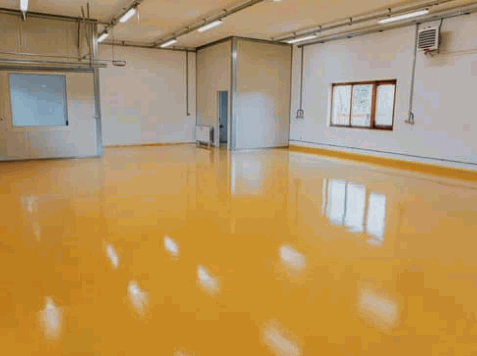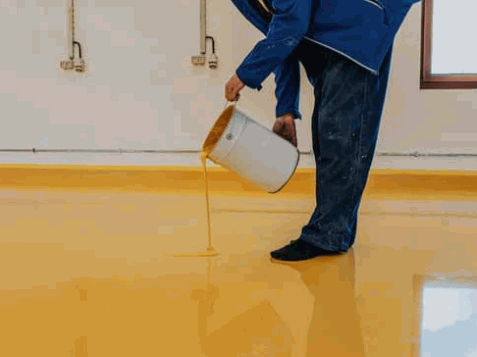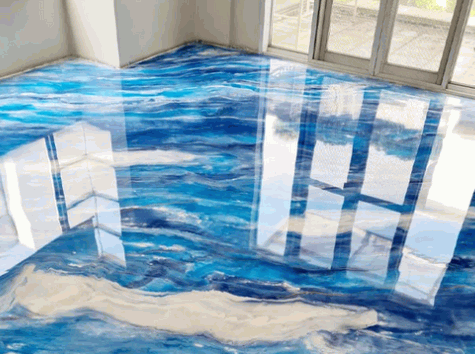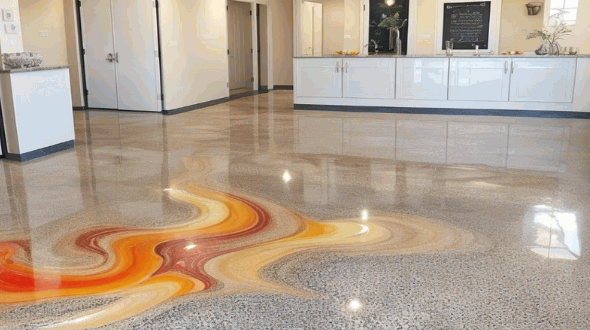Epoxy flooring is a great pick for both home and business spots. It gives a solid, smooth surface that looks good and it’s easy to keep clean. The process includes adding a resin layer to the existing floor. This makes it hard-wearing safe from chemicals, and able to take lots of foot traffic, impacts, and spills.
One of the top advantages of epoxy flooring is its flexibility. It can be used on many different surfaces, like concrete, wood, or tile. This means it’s a perfect choice for those who want to upgrade their floors without costly renovations.
Installing epoxy flooring has several steps:
- First, the existing floor must be cleaned and prepped so the resin sticks properly.
- Then, any cracks or damage are fixed before the primer coat is added.
- After the primer is dry, multiple layers of epoxy are put on to get the right thickness and look.
- At last, a top coat is applied for added protection and durability.
DIY epoxy flooring might seem scary, but it can be done with enough effort. There are lots of tutorials and step-by-step instructions online that help homeowners get the job done.

Benefits Of DIY Epoxy Flooring
Epoxy flooring is a top choice for DIY projects, thanks to its many advantages! It provides durability, simple maintenance, and attractive appeal.
- Durability: This flooring is durable enough for high-traffic areas. The epoxy coating is strong and resilient, so it can take on heavy loads and daily use.
- Easy Maintenance: Cleaning is a breeze with DIY epoxy flooring. Its smooth surface won’t let dust, dirt, or stains get in – just sweep or mop away!
- Aesthetic Appeal: DIY epoxy flooring comes in many colors and finishes, so you can get the look you want. Whether you prefer glossy or textured, epoxy coatings give any space a boost in style.
Plus, it’s resistant to chemicals, oils, and moisture. So it’s great for garages, basements, workshops, and other places with spills or moisture.
Delve into: Can Epoxy Flooring Be Used In Bathrooms
Materials And Tools Needed
Successfully DIY-ing epoxy flooring requires specific materials and tools. Here’s what you need:
Materials:
- Epoxy resin
- Hardener
- Pigments/Flakes (optional)
- Primer
- Cleaner/Etcher
Tools:
- Trowel
- Roller
- Mixing container
- Squeegee
- Gloves/Safety goggles
Plus, be sure to wear appropriate clothing and footwear while working with epoxy. Lastly, apply pigments/flakes during the final coat for great results.

Preparing The Surface For Epoxy Application
Preparing your surface for epoxy is essential. We’ll explain the process in an informative way.
- Clean the surface: Remove any dirt, grease, or debris by sweeping or vacuuming. Use a degreaser for tough stains.
- Fix any damage: Check for cracks, holes, or imperfections. Fill them and create a level surface.
- Check moisture levels: Excessive moisture can cause problems. Test with calcium chloride or plastic sheet test. Consider applying a barrier if moisture is high.
- Etch or grind (if needed): Smooth surfaces like concrete may need etching or grinding to improve adhesion.
Additional points to remember: avoid acid-based cleaners, ensure ventilation, and follow the manufacturer’s instructions.
By following these steps and requirements, you will achieve a beautiful, durable flooring solution.
Applying The Epoxy Coating
To make the process successful, follow these steps to coat your floor with epoxy:
- Clean the floor, removing dirt, grease, and stains. Fix any cracks or imperfections and let the surface dry.
- Mix the epoxy resin and hardener, as per the manufacturer’s instructions. Use a clean bucket and stir until blended.
- Apply with a roller or brush, starting from one corner. Do small sections and use long overlapping strokes.
- Follow the manufacturer’s instructions for curing time. This could be several hours or overnight. Once cured, add a second coat.
Remember that humidity and temperature can affect drying times and results. Ventilate the area during application and don’t walk on the wet surface until it’s dry. Ready to get started? You can DIY a stunning epoxy floor and be proud of your results! Enjoy it for years to come.

Curing And Drying Process
The curing and drying process in DIY epoxy flooring is a must. It ensures that the epoxy resin hardens and sets properly, creating a durable, long-lasting floor. Let’s look closer.
| Step | Duration | Description |
| 1 | Initial Cure | 24-48 hours |
| 2 | Full Cure | 5-7 days |
The initial curing period is 24-48 hours after applying epoxy. During this time, the epoxy starts to harden, but not completely. Foot and vehicle traffic must be avoided during this stage to prevent any damage.
Next, the full curing process begins. This step takes 5-7 days for the epoxy to fully harden. The area should be well-ventilated and moisture-free during this time.
To ensure a successful curing process, keep the temperature around 70°F (21°C) throughout the curing duration. Extreme temperatures can damage the epoxy and cause cracks.
Don’t rush or skip any steps in the curing and drying process. Taking shortcuts can risk the quality and longevity of your epoxy floor. Follow the guidelines carefully for optimal results. Patience will be rewarded with a stunning, long-lasting floor. Start your epoxy flooring project now and enjoy the benefits!
Learn more: The Science Behind The Epoxy Curing Process
Maintenance Tips For Epoxy Flooring
Maintaining epoxy flooring is essential to keep it looking pristine. Here are three key tips:
- Sweep or vacuum regularly to remove dust and debris.
- Use a mild detergent and warm water for stains or spills.
- Place mats or rugs at entryways to avoid dirt and moisture.
Moreover, avoid harsh chemicals and heavy impacts. Furniture pads or coasters will also help prevent scratches.
Epoxy flooring has been around for decades. It was initially used in industrial warehouses but has gained popularity due to its low maintenance requirements. Nowadays, it’s used in both commercial and residential settings for its sleek look and practicality.

Conclusion And Final Tips
Before applying epoxy flooring, it’s essential to prepare the surface. This means cleaning it well, fixing any cracks or damage, and allowing it to dry. Stick to the manufacturer’s instructions for mixing and applying the epoxy.
Work efficiently and methodically when applying the epoxy. Start by cutting in the edges with a brush or roller, then roll on the epoxy in small sections. This helps to get an even application and stops the epoxy from drying too quickly.
Be aware of the temperature and humidity conditions during application. Extremes in either can affect the curing process of the epoxy, potentially leading to bubbles or other issues. Try to pick a day with moderate weather for better results.
Take it up a level with decorative flakes or pigments for a unique look. These add extra beauty and make the floor more resistant to stains or chemicals.
To sum it up: proper preparation, careful application techniques, environmental conditions, and creative customization options are the keys to DIY epoxy flooring success. Get going!
Uncover more: Is Epoxy Flooring Good For Kitchens

